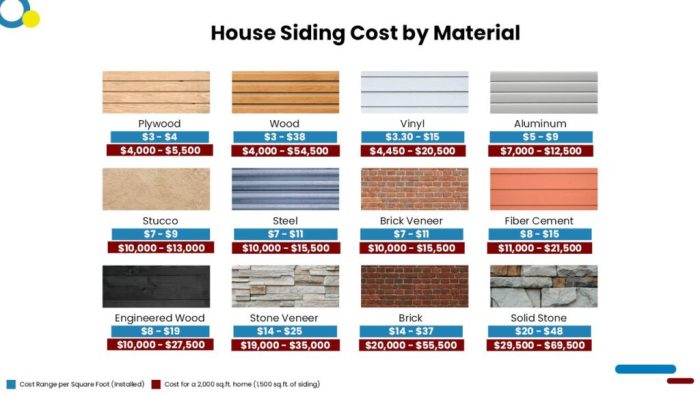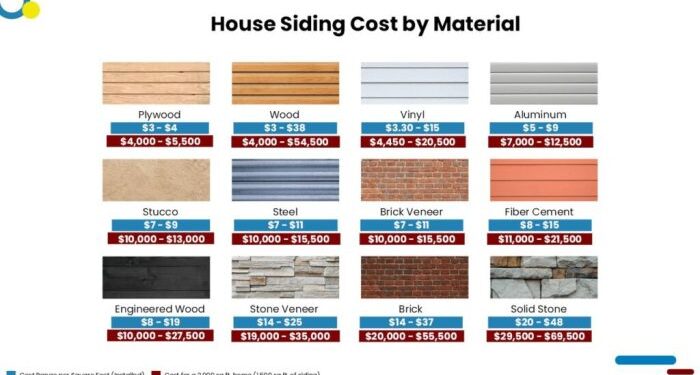Embark on a journey through the intricacies of siding replacement as we delve into the realm of hidden costs that could catch homeowners off guard. From unforeseen expenses to the impact of material choices, this exploration promises to shed light on crucial aspects often overlooked in budgeting for siding projects.
Hidden Costs of Siding Replacement
When planning to replace siding on a home, it's essential to consider all potential hidden costs that may arise during the project. These additional expenses can significantly impact the overall budget and should be factored in from the beginning to avoid any surprises down the line.
Unforeseen Structural Issues
One of the most common hidden costs during a siding replacement project is the discovery of unforeseen structural issues. Once the old siding is removed, contractors may uncover damage to the underlying structure, such as rot or mold, which will need to be addressed before the new siding can be installed.
Repairing these issues can add a substantial amount to the total cost of the project.
Permit Fees and Regulations
Another hidden cost to watch out for when replacing siding is permit fees and compliance with local regulations. Depending on where you live, you may need to obtain permits for the work, which can come with additional costs. It's essential to research the permit requirements in your area and include these fees in your budget.
Trim and Finish Work
Many homeowners overlook the cost of trim and finish work when budgeting for a siding replacement project. While the primary focus is often on the siding material itself, the trim around windows, doors, and corners also needs to be replaced or updated to ensure a cohesive look.
The cost of trim work should be factored into the overall budget to avoid any surprises.
Impact of Material Selection
When it comes to replacing siding, the choice of material can significantly impact the total cost of the project. Different siding materials come with varying costs, durability, maintenance requirements, and long-term implications.
Popular Siding Materials
- Vinyl: Vinyl siding is one of the most affordable options upfront, making it a popular choice for many homeowners. It requires minimal maintenance and is relatively easy to install, which can help reduce labor costs.
- Wood: Wood siding provides a natural and classic look to a home but tends to be more expensive than vinyl. However, maintenance costs can add up over time, as wood requires regular painting or staining to prevent rot and decay.
- Fiber Cement: Fiber cement siding is a durable and low-maintenance option that can mimic the look of wood or stucco. While the initial cost may be higher than vinyl, fiber cement siding is known for its longevity and resistance to pests and rot.
- Stucco: Stucco siding offers a unique and textured finish to a home but can be one of the costliest options upfront. However, stucco is known for its durability and can last for several decades with minimal maintenance.
It is essential to consider not only the initial cost but also the long-term maintenance and repair expenses when selecting a siding material for your home.
Labor and Installation Costs
Replacing siding involves more than just material costs; labor and installation expenses are significant factors that can impact the overall budget. Hiring professional installers is crucial to ensure the job is done correctly and efficiently, but this expertise comes at a price.
Here, we will delve into the labor costs involved, the importance of hiring skilled contractors, and how to find reputable professionals while staying within budget constraints.
Labor Costs in Siding Replacement
When replacing siding, labor costs can vary depending on the size of the project, the complexity of the installation, and the location of your home. On average, labor typically accounts for 25% to 50% of the total project cost. Factors such as removing old siding, preparing the surface, and installing the new siding all contribute to the labor expenses.
Importance of Hiring Professional Installers
While it may be tempting to cut costs by attempting a DIY siding replacement, hiring professional installers is crucial for a successful and long-lasting result
Their expertise can help avoid costly mistakes and ensure that the siding is installed properly, minimizing the risk of future repairs.
Finding Reputable Contractors
When looking for contractors, it's essential to do your research and find reputable professionals who offer quality work at a fair price. Ask for recommendations from friends, family, or neighbors, and read reviews online to gauge the reputation of potential contractors.
Obtain multiple quotes to compare prices and services offered, but remember that the lowest bid may not always be the best option. Look for contractors who are licensed, insured, and have a proven track record of successful siding installations.
Permits and Regulations
When replacing siding on your home, it is important to consider the role that permits and regulations play in the overall cost of the project. Failure to obtain the necessary permits can lead to unexpected expenses and even legal issues down the road.
Common Permit Requirements and Costs
Obtaining permits for siding replacement is typically required by local building codes to ensure that the work is done safely and up to standard. The cost of permits can vary depending on the location and the scope of the project.
Here are some common permit requirements and their associated costs:
- Building Permit: This permit is usually required for any major construction or renovation project, including siding replacement. The cost can range from $100 to $500 or more, depending on the value of the project.
- Zoning Permit: Some areas may require a zoning permit to ensure that the siding replacement complies with local zoning laws. This permit can cost anywhere from $50 to $200.
- Historic District Approval: If your home is located in a historic district, you may need to obtain approval from the local historic preservation commission before making any changes to the exterior of the home. The cost of this approval can vary.
Wrap-Up

As we conclude our discussion on hidden costs when replacing siding, it becomes evident that meticulous planning and consideration are key to a successful project. By being aware of these factors, homeowners can navigate the complexities of siding replacement with confidence and financial prudence.
Expert Answers
What are some common hidden costs during siding replacement?
Some common hidden costs include structural repairs, disposal fees for old siding, and possible permit expenses.
How does the choice of siding material impact overall costs?
The choice of siding material can significantly affect costs, with options like wood generally being more expensive than vinyl.
Why is it crucial to hire professional installers for siding replacement?
Professional installers ensure quality workmanship and can help avoid costly mistakes that may inflate the project's expenses.
What are the typical permit requirements for siding replacement projects?
Common permit requirements may include approvals for structural changes and adherence to local building codes, each potentially adding to the overall cost.
















